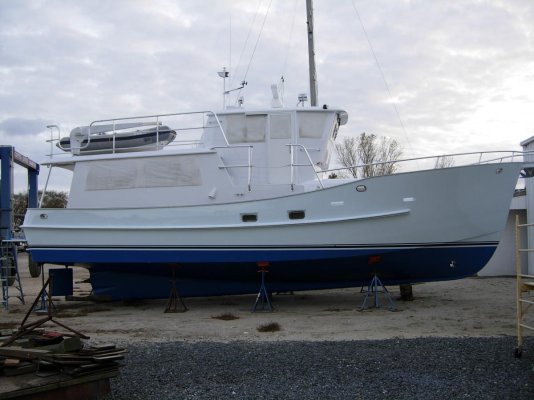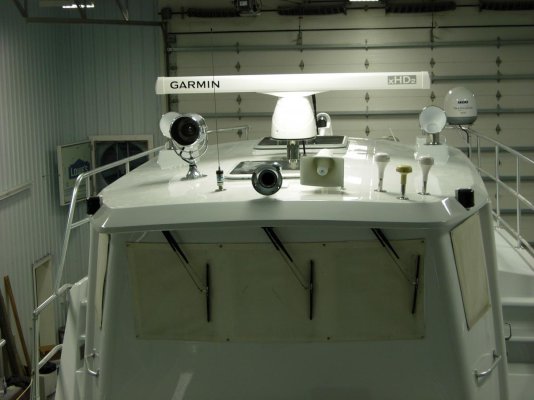Would a 6ft array be too large, with too tight a beam width, for a 50ft trawler? The goal has nothing to do with range, only better target discrimination. However, even a stabilized 50ft will have large motions compared to a much larger vessel.
You are using an out of date browser. It may not display this or other websites correctly.
You should upgrade or use an alternative browser.
You should upgrade or use an alternative browser.
Radar Array - maximum usable size
- Thread starter Mako
- Start date
The friendliest place on the web for anyone who enjoys boating.
If you have answers, please help by responding to the unanswered posts.
If you have answers, please help by responding to the unanswered posts.
O C Diver
Guru
- Joined
- Dec 16, 2010
- Messages
- 12,868
- Location
- USA
- Vessel Name
- Slow Hand
- Vessel Make
- Cherubini Independence 45
That's exactly what I did on my 45' pilothouse trawler. On my radar, 90% of the weight is directly over the pedestal in the base. The array weighs very little.Would a 6ft array be too large, with too tight a beam width, for a 50ft trawler? The goal has nothing to do with range, only better target discrimination. However, even a stabilized 50ft will have large motions compared to a much larger vessel.


My 6' open array Garmin radar is 14' 3" +/- off the water. I can still see a small USCG channel buoy at 75 to 100' from off my bow to off my beam. I'm not targeting anything with the Photon Torpedo system that's any closer than that to me.
Ted
A 6' array will give you better target resolution, even on a bouncing boat. Think about it, as the beam sweeps in a circle, the only motion that will affect resolution is one that moves the beam horizontally- yaw. Boat's don't move fast in yaw, even in heavy seas.
But I don't think you will see meaningful improvements over a 4' array.
David
But I don't think you will see meaningful improvements over a 4' array.
David
But I don't think you will see meaningful improvements over a 4' array
So OC Diver, do you feel that your 6' array is significantly better than a 4' and worth another grand in antenna price?
O C Diver
Guru
- Joined
- Dec 16, 2010
- Messages
- 12,868
- Location
- USA
- Vessel Name
- Slow Hand
- Vessel Make
- Cherubini Independence 45
To be honest, I don't know yet. Mine is a 6KW which is more power than I need. I might very well have been happy with the 4'; you adapt to what you have to work with. I saw no down side other than the $$$$. For me, it's about potential target separation. When traveling in reduced visibility, is it the seabouy I see or is there another boat next to the seabouy? I like what I see so far; time will tell with more days on the unit. Unfortunately it's not easy to get a good side by side comparison of a 4' and 6' radar display.So OC Diver, do you feel that your 6' array is significantly better than a 4' and worth another grand in antenna price?
This unit is pretty neat in that you can run split screen with 2 different scales. Currently playing with 6 miles and 1 mile. In the smaller areas this seems to work well. Keep track of what's close while scanning for up coming vessels. Will probably switch to 10 miles and 1 mile when getting into the shipping lanes where the big boats travel faster.
Ted
angus99
Guru
To be honest, I don't know yet. Mine is a 6KW which is more power than I need. I might very well have been happy with the 4'; you adapt to what you have to work with. I saw no down side other than the $$$$. For me, it's about potential target separation. When traveling in reduced visibility, is it the seabouy I see or is there another boat next to the seabouy? I like what I see so far; time will tell with more days on the unit. Unfortunately it's not easy to get a good side by side comparison of a 4' and 6' radar display.
This unit is pretty neat in that you can run split screen with 2 different scales. Currently playing with 6 miles and 1 mile. In the smaller areas this seems to work well. Keep track of what's close while scanning for up coming vessels. Will probably switch to 10 miles and 1 mile when getting into the shipping lanes where the big boats travel faster.
Ted
Hey, Ted, if you're able to perceive a significant difference after using the 6-foot array awhile, it would be great if you'd post your impressions. I'm looking at the same choices this spring. Thanks.
O C Diver
Guru
- Joined
- Dec 16, 2010
- Messages
- 12,868
- Location
- USA
- Vessel Name
- Slow Hand
- Vessel Make
- Cherubini Independence 45
I run mine whenever underway. Hope to be leaving Crisfield, MD for Fort Myers, FL by the end of the week. Will try to remember to update this thread when I get there. That should be 150+ hour of use.Hey, Ted, if you're able to perceive a significant difference after using the 6-foot array awhile, it would be great if you'd post your impressions. I'm looking at the same choices this spring. Thanks.
Ted
O C Diver
Guru
- Joined
- Dec 16, 2010
- Messages
- 12,868
- Location
- USA
- Vessel Name
- Slow Hand
- Vessel Make
- Cherubini Independence 45
Hey, it's not all rosy here in Salisbury, MD. We got 4" of snow Friday night! That was mostly washed away by rain on Saturday. But it did snow again last night! Will probably take a couple of days for that 2" to melt.Thanks. Have a great trip and try not to think of us back here in the snowpack.

Ted
Let me answer the question of display resolution of a 4' and 6' array theoretically. Resolution, the ability to resolve separate objects close together (in terms of distance between them) is inversely proportional to array size.
So if you can just barely make out a gap between two objects 50' apart at 1 mile with a 4' array, then you can make out a gap between two objects 33' apart with a 6' array. If that 17' difference is important to you, go with the 6' array.
David
So if you can just barely make out a gap between two objects 50' apart at 1 mile with a 4' array, then you can make out a gap between two objects 33' apart with a 6' array. If that 17' difference is important to you, go with the 6' array.
David
MYTraveler
Guru
First, I don't think there is ever a circumstance in which the slightly narrower beam of a 6' array, as compared to that of a 4' array, is a disadvantage. It should also be noted that the beam is only narrow horizontally, not vertically, so even if the boat is pitching and rolling heavily, the 6' array will not be at a disadvantage.
For those asking for a comparison of 4' and 6' arrays, let me offer my experience with a Furuno 6kw 4' and a Furuno 25kw 6'. The 4' is amazing. The 6' is a little bit better, in terms of target separation and sharpness, but that difference can be perceived only by careful study of a side by side comparison. I will say that the 6' is better at picking up birds, but not because of its beamwidth, but instead because it is putting out so much more power (25kw) on targets that are not good reflectors.
For those asking for a comparison of 4' and 6' arrays, let me offer my experience with a Furuno 6kw 4' and a Furuno 25kw 6'. The 4' is amazing. The 6' is a little bit better, in terms of target separation and sharpness, but that difference can be perceived only by careful study of a side by side comparison. I will say that the 6' is better at picking up birds, but not because of its beamwidth, but instead because it is putting out so much more power (25kw) on targets that are not good reflectors.
Right rudder
Veteran Member
Target separation
If you are trying to separate and see two targets that are close together, horizontal and vertical beam width are not the go to items, Band width and pulse repetition rate come into play. The very same two adjustments used to reduce sea return.
If you are trying to separate and see two targets that are close together, horizontal and vertical beam width are not the go to items, Band width and pulse repetition rate come into play. The very same two adjustments used to reduce sea return.
O C Diver
Guru
- Joined
- Dec 16, 2010
- Messages
- 12,868
- Location
- USA
- Vessel Name
- Slow Hand
- Vessel Make
- Cherubini Independence 45
So you're saying, everything else being equal, there's no difference in target separation between a 24" and a 72" array?If you are trying to separate and see two targets that are close together, horizontal and vertical beam width are not the go to items, Band width and pulse repetition rate come into play. The very same two adjustments used to reduce sea return.
Ted
Jetstream
Senior Member
I'm no expert on marine radar but what about the broadband options like the Simrad 3G and 4G units? There is no PRF as such and they do claim very good target separation. As well because they don't transmit in pulses there is no minimum range issues because of the pulse length.
Right rudder
Veteran Member
So you're saying, everything else being equal, there's no difference in target separation between a 24" and a 72" array?
It's not the size of the equipment that counts, it's what you do with it that counts.....like putting the correct pulse width through it for the situation at hand. If your radar has a (PW) knob or switch, use it, get familiar with it. As you decrease the PW, the pulse rep rate increases the pulse width becomes narrower and will start to fit the space between two close objects and only then will you will get an echo from both.
24" or 72" array....I Would consider the 24" a navigation set up with a better than average pulse rep rate, the 72" then becomes a search set up out to and beyond the horizon with a wider pulse width and a lower RPM.
If I could have but one radar, I would choose the 24" navigation set up. It can see at least 10-12 miles and it's going to take me an hour or two to get there.
O.C. You are correct, The advantage the 72" might hold is that it could be more sensitive...if the pulse is identical and one cannot see separation the other will not.
Right rudder
Veteran Member
I'm no expert on marine radar but what about the broadband options like the Simrad 3G and 4G units? There is no PRF as such and they do claim very good target separation. As well because they don't transmit in pulses there is no minimum range issues because of the pulse length.
For the love of Pete......just when I thought I was up to date, Jetstream throws me a knuckle ball. I'm going to bed, schooling begins tomorrow I guess.
Similar threads
- Locked
- Replies
- 4
- Views
- 1K
